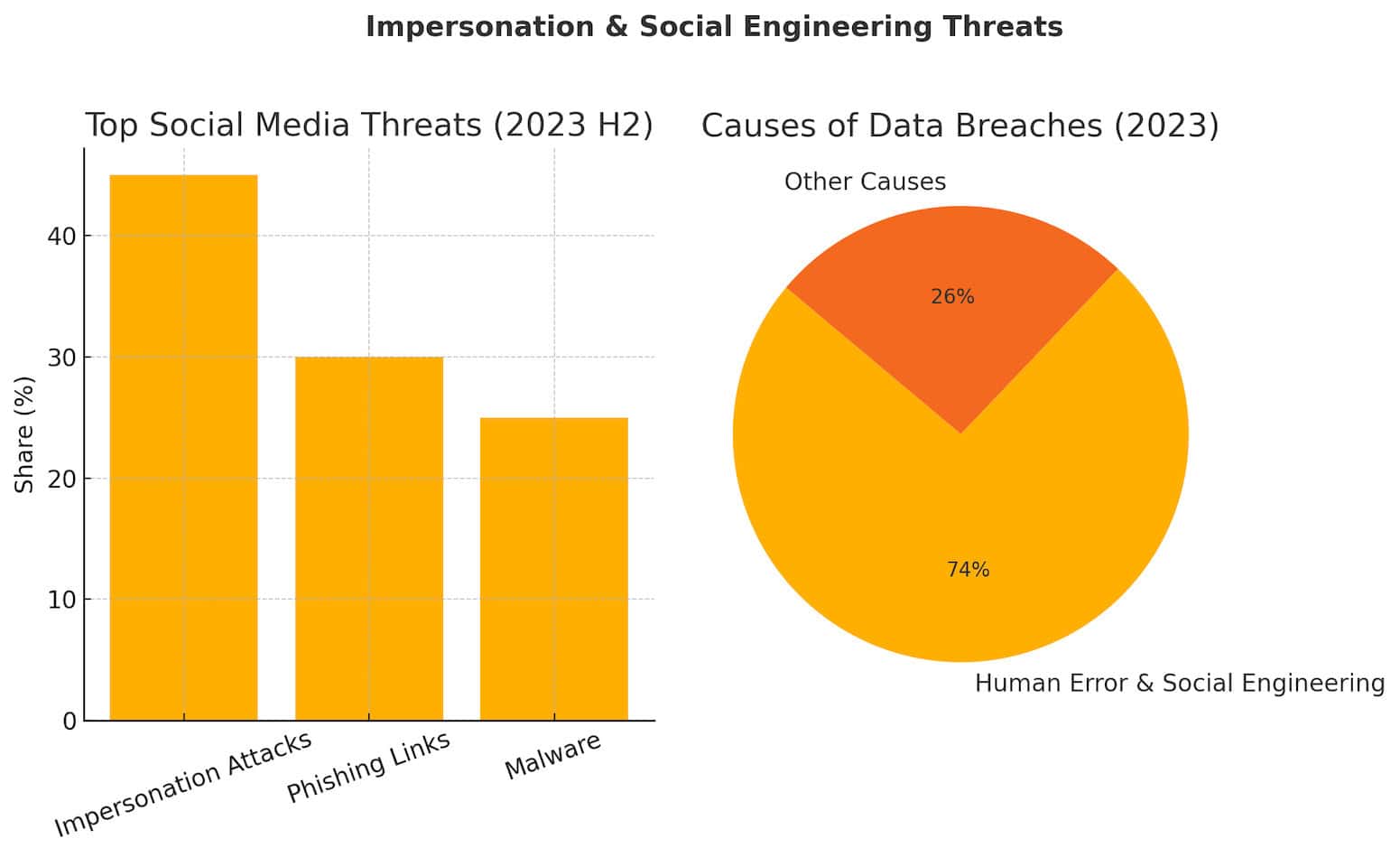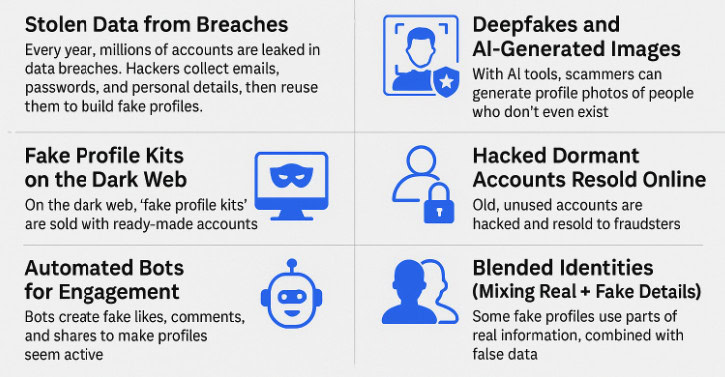Someone may create a fake Facebook account with your name, photo, and details. At first, it may look like a small problem, but it can turn into a serious threat. A fake account can fool your friends, family, or coworkers. It can send them requests, ask for money, or spread false posts that harm your good name.
Fake accounts are not rare. Facebook reports millions of them every quarter. Many people do not notice until someone close points it out. The danger is real because people trust your name and face. If they see a post or message from someone who appears to be you, they may believe it is genuine.
Fake accounts are one of the most common forms of online impersonation, and they can do serious damage. In fact, impersonation attacks became the leading social media threat in the second half of 2023, surpassing other scams like phishing links and malware.
Often, it’s not even about you personally; it’s about your network. Attackers exploit trust by using your identity to trick your friends or family into clicking malicious links, sharing personal information, or even sending money.
According to Verizon’s 2023 Data Breach Investigations Report, 74% of breaches involve human error or social engineering, proving that manipulation is one of the strongest weapons in cybercrime.

Contents
Why Does Someone Create a Fake Account in your name?
Fake profiles are not just harmless jokes. They are often built with specific goals that can damage trust, money, or reputation. Now, let’s find out the key reasons:
1. Identity Theft for Financial Gain
Many fake profiles steal names, photos, and personal details to trick others. Scammers often use them for fraud, phishing, or selling stolen identities on the dark web. They collect personal info and link it to banking scams, and sometimes these profiles are used to apply for loans or credit cards.
2. Social Engineering & Trust Exploitation
Fraudsters know people trust friendly faces. Fake accounts use this to gain access to private info or convince victims to share secrets. They may pretend to be a coworker, family member, or even an authority figure. Once trust is built, they manipulate victims into sending money or sensitive files.
3. Revenge or Personal Grudges
Some fake accounts are created out of anger. Ex-partners, jealous friends, or rivals may impersonate someone to spread lies or embarrass them. These profiles can damage careers and personal relationships.
4. Digital Reputation Laundering
People with shady pasts may create fake accounts to rebuild a “clean” online image. By hiding behind new profiles, they distance themselves from negative stories.
5. Political or Ideological Influence
Fake profiles often push agendas. Troll farms and propaganda groups use them to spread misinformation, influence elections, or stir division.
6. Reputation Sabotage
Sometimes fake accounts exist only to ruin others’ reputations. They spread false rumors, fake reviews, or offensive comments to damage someone’s credibility.
Protect Your
Social Media Reputation
Look for duplicate sites, fake profiles, or leaks (digital products) that can damage reputation.
Get Started
Modern Techniques Used in Fake Profile Creation:
Fake profiles have become more advanced over the years. In the past, scammers only copied photos and names. But now, with AI and new tools, fake identities can look extremely real.
Many people can’t tell the difference at first glance, which is what makes them so dangerous. These techniques allow scammers to reach thousands of people at once, making detection harder, and knowing how they create these fake profiles helps us spot red flags quickly.

What To Do When Someone Made My Fake Facebook Account – Using Name & Pictures
If you ever find that someone is impersonating you online, it can be stressful and even dangerous. A fake profile can harm your reputation, trick your friends, or even lead to financial scams. Acting quickly is the key to protecting yourself. Below are the steps you should follow:
Step 1: Confirm the Fake Profile Exists
Before reacting, you must verify that the profile is absolutely fake. Sometimes, people may have the same name or similar photos by coincidence. You should check details like username, friends list, and shared posts. A genuine impersonator often copies your photos, bio, or even job details to look believable.
Just compare the account with your real one side by side. Ask a trusted friend to review it too, since an outside perspective often spots red flags faster. Once you’re confident it’s an impersonation, do not engage with the account. Engaging may give the scammer more information. Instead, move to documenting it.
Step 2: Gather Proof (Screenshots, URLs, Messages)
Evidence is needed. First, take clear screenshots of the fake account, including the profile page, photos, friend requests, and any messages sent to others. Just copy the profile URL directly, since scammers often change usernames to avoid being caught.
Also, save timestamps of any suspicious messages or posts. You can also collect reports from friends who may have interacted with the fake account, as these add credibility. You should store all proof in one folder on your phone or computer, as having this organized evidence helps social media platforms, legal authorities, or workplace HR respond faster.
Step 3: Report on the Platform
Every social media platform has built-in reporting tools for impersonation. On Facebook and Instagram, you can click the “Report Profile” button and choose “Pretending to Be Someone”. Platforms often review impersonation cases within 24–72 hours, though response times may vary.
While reporting, never message the impersonator directly, as that only warns them to change tactics or hide the account.
Step 4: Notify Friends and Family
Your loved ones and professional contacts should be made aware of the fake profile. A scammer may try to reach them first, pretending to be you. You should post a public update on your real social media accounts, warning people not to accept new requests from fake accounts.
You can also send private messages to close contacts if needed, especially if the impersonator is actively sending requests or scams. This quick communication prevents others from being tricked into sending money, sharing personal details, or spreading false information.
Step 5: Escalate to Police or Cybercrime
If the impersonation involves threats, financial scams, or defamation, reporting to the police or your country’s cybercrime unit is important. Many regions now have dedicated cybercrime cells that deal with identity theft cases. Provide them with all your collected proof: screenshots, links, timestamps, and platform reports.
If money was stolen from friends or business contacts, this adds legal weight to your case. In serious cases, the police can request user data directly from social media companies to track the scammer. Filing a formal report also creates an official record, which may be required later if the impersonation affects your career, finances, or reputation.
Explain the Damage: Highlight financial fraud, threats, or defamation caused by the impersonator.
Support with Proof: Share reports from friends who interacted with the fake account.
Track the Scammer: In severe cases, authorities can request data from social media companies to trace the culprit.
Step 6: Explore Data Protection & Privacy Laws
Depending on where you live, privacy and data protection laws can support you. In Europe, GDPR gives individuals the right to request that platforms remove or block misuse of their personal data. The U.S. has state-specific laws under identity theft statutes.
First, learn which laws apply in your region and quote them when contacting authorities or platforms. Sometimes, platforms respond faster when you mention the legal framework. If the impersonation case damages your career or business reputation, you may also consider consulting a lawyer who specializes in cyber law.
File a Legal Notice: Quote the relevant law when writing to platforms or authorities.
Seek Professional Help: Consult a cyber law attorney if the impersonation impacts your business or career.
Push for Action: Platforms and authorities often act faster when legal language is included in complaints.
How to Detect a Fake Profile:
Detecting fake profiles is not always easy, but there are clear warning signs that help. Most scammers leave small mistakes or unusual patterns that reveal their true identity. Now, learning to recognize these signs makes it harder for them to fool you.
Social media platforms try to remove fake accounts, but many slip through daily. That’s why it’s important to double-check any suspicious profile you come across.
1. Reverse Image Search of Profile Photos
Scammers often use stolen or AI-generated images. Running a reverse search on tools like Google Images or TinEye can show if the photo is linked to multiple profiles or stock images.
2. Inconsistent Friend List or Network
A fake profile usually has a random mix of friends from different countries or no real-life connections. If their list looks too scattered or unnatural, it’s a sign of impersonation.
3. Poor Grammar or Copy-Paste Posts
Most fake accounts use automated posts or stolen captions. Also, look for repeated content, broken English, or irrelevant comments. These errors often reveal a bot or scammer behind the account.
4. Recently Created Accounts with Old Photos
Some profiles appear new but include photos that claim to be from years ago. This mismatch between account age and content is a common indicator of potential issues.
5. Suspicious Links in Messages
Fake accounts often send links promising free gifts, contests, or shocking news. Clicking these links can lead to phishing websites or malware. Always check the URL before opening.
How can I protect myself from fake profiles and avoid the consequences of impersonation?
This is one of the most searched concerns online. Many people fear the lasting damage fake profiles can cause: financial loss, reputational harm, or even identity theft.
1. Strengthen Your Online Security
The first line of defense is your own, i.e. always use strong, unique passwords for each account and enable two-factor authentication (2FA). This ensures that even if scammers steal your login details, they can’t easily access your profile.
Regularly update your devices and apps to patch vulnerabilities. Also, monitor login notifications on your accounts and act immediately if an unknown device is detected. These measures reduce the chance of someone hacking or cloning your identity to create fake accounts.
2. Limit Publicly Shared Personal Information
Oversharing is one of the biggest enablers of impersonation. Many fake profiles start with stolen names, photos, or contact details. Reduce what strangers can see by adjusting privacy settings on platforms like Facebook, Instagram, and LinkedIn.
You must consider hiding your friend list, date of birth, workplace, and contact numbers. Avoid posting sensitive personal updates like travel plans, ID cards, or family details. Even a simple email address or phone number can be misused for scams. When you keep your online presence limited to trusted circles, scammers have less material to exploit.
3. Act Quickly When Impersonation Happens
Immediately gather evidence (screenshots, links, and timestamps) and report the profile on Facebook (or where the profile is). At the same time, alert your friends and family so they don’t fall victim to scams. Update your real profile with a post warning others not to engage with impersonators. The quicker you respond, the less chance the fake profile has to damage your reputation or defraud people.
4. Stay Informed and Legally Prepared
AI-generated deepfakes and bots make fake accounts harder to detect. Following cybersecurity updates, blogs, or government advisories helps you recognize these new tricks. On the legal side, know your rights. For example, GDPR in Europe protects victims of identity theft, while many U.S. states enforce strict impersonation laws.
📌 Tip
If needed, consult a lawyer who specializes in cyber law. Being prepared both technologically and legally ensures that if impersonation affects your career, finances, or reputation, you can respond with authority and minimize damage.
Frequently Asked Questions:
Creating a fake profile may not always be illegal, but if it’s used for identity theft, fraud, defamation, or harassment, it can become a criminal act. Legal consequences vary by jurisdiction, ranging from platform bans to fines or imprisonment.
Check for red flags like recently created accounts, minimal posts, mismatched URLs, or overwhelmingly attractive profile photos. Use reverse image searches, compare friend lists, and ask for video verification. Inconsistencies often expose impersonators.
First, confirm the impersonation exists. Then report the account via the Instagram app or web form under “pretending to be someone else.” Alert your followers to prevent scams, and escalate the case or involve legal action if harassment or fraud continues.
Yes, even if you don’t have a Facebook account, you can use the Impersonation Form available in Facebook’s Help Center to report someone using your name or photo.

